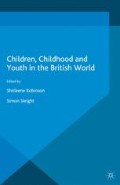Abstract
On 11 July 1940, Marie Williamson sat down in her Toronto home to write a letter which would forever change the lives of two families. Already raising two small children of her own, Marie wrote to Margaret Sharp, her cousin in England, with an offer to care for Margaret’s three sons for the duration of the war. Her letter heralded the worsening circumstances of the conflict. The fall of France in the spring of 1940 had raised fears that an invasion of Britain could be imminent. Heightened anxiety was soon transposed onto Britain’s children; it was they who were regarded as most at risk of both physical and psychological trauma, and in need of removal from harm’s way. ‘The more children we can have out of England the better we will be pleased’, Marie Williamson wrote, illustrating her determination to offer practical assistance.1 Like thousands of Canadians who put pen to paper to offer safe homes to British children, Marie promised that she, her family and her friends would ‘clothe and look after the boys just as though they were [their] own.’2
Access this chapter
Tax calculation will be finalised at checkout
Purchases are for personal use only
Preview
Unable to display preview. Download preview PDF.
Notes
Martin Parsons and Penny Starns, ‘Against Their Will’, in James Marten (ed.), Children and War (New York: New York University Press, 2002), 266–78;
Sue Wheatcroft, ‘Children’s Experiences of War’, Twentieth Century British History, vol. 19, no. 4 (2008), 480–501.
Richard Titmus, Problems of Social Policy (London: His Majesty’s Stationery Office, 1950);
Travis Crosby, The Impact of Civilian Evacuation in the Second World War (London: Croom Helm, 1986);
John Macnicol, ‘The Effect of Evacuation of Schoolchildren on Official Attitudes to State Intervention’, in H. Smith (ed.), War and Social Change (Manchester: Manchester University Press, 1986), 3–31.
Carlton Jackson, Who Will Take Our Children? (London: Methuen, 1985);
Ruth Inglis, The Children’s War (London: Harper Collins, 1989).
Only recently have scholars begun to complicate this image — see Berry Mayall and Virginia Morrow, You Can Help Your Country: English Children’s Work During the Second World War (London: Institute of Education, 2011).
Geoffrey Bilson, The Guest Children (Saskatoon: Fifth House, 1988).
Ruth Inglis and Michael Fethney, The Absurd and the Brave (Sussex: Book Guild, 1990) briefly discuss the CORB evacuees in the Dominions.
Hugh Cunningham, ‘Introduction’, in Children and Childhood in Western Society Since 1500 (Harlow: Pearson Longman, 2005), 1–17.
Martha Saxton, ‘Introduction’, Journal of the History of Childhood and Youth, vol. 1, no. 1 (2008), 1–3.
See Cynthia Comacchio, The Dominion of Youth (Waterloo: Wilfred Laurier University Press, 2006),
Veronica Strong-Boag, Fostering Nation? Canada Confronts its History of Childhood Disadvantage (Waterloo: Wilfred Laurier University Press, 2006).
Shurlee Swain and Margot Hillel, Child, Nation, Race and Empire: Child Rescue Discourse, England, Canada and Australia, 1850–1915 (Manchester: Manchester University Press, 2010).
June Rose, For the Sake of the Children: Inside Dr. Barnardo’s (London: Hodder and Stoughton, 1987).
Larry Prochner and Nina Howe, ‘The Wartime Child Care Centres in Canada and Great Britain’, Canadian Children, vol. 26, no. 2 (2001), 21–27; Canadian Museum of Immigration, British Evacuee Child Collection, ‘98.05.28 TF: Thelma Freedman’;
Jocelyn Raymond, The Nursery World of Dr Blatz (Toronto: Toronto University Press, 1991).
Mary Byers, Havergal: Celebrating a Century, 1894–1994 (Erin: Boston Mills Press, 1994), 110.
Jenny Hartley, ‘“Letters Are Everything These Days”: Mothers and Letters in the Second World War’, in Rebecca Earle (ed.), Epistolary Selves: Letters and Letter-Writers, 1600–1945 (Aldershot: Ashgate, 1999), 183.
Lee Cooper, ‘From “Love Letters” to “Miss You”’, Journal of American Culture, vol. 19, no. 4 (1999), 193.
Helen Brown, ‘Negotiating Space, Time, and Identity: The Hutton-Pellett Letters and a British Child’s Wartime Evacuation to Canada’, in Bruce Elliott, D. Gerber and S. Sinke (eds), Letters Across Borders: The Epistolary Practices of International Migrants (New York: Palgrave Macmillan, 2006).
Young Tom was depicted as such in Mary Williamson and Tom Sharp (eds), Just A Larger Family: Letters of Marie Williamson from the Canadian Home front, 1940–1944 (Waterloo: Wilfred Laurier University Press, 2011).
Claire Halstead, ‘From Lion to Leaf: The Experiences of British Children Evacuated to Canada in the Second World War’ (PhD thesis, University of Western Ontario, forthcoming). Also see Claire Halstead, ‘“Dangers Behind, Pleasures Ahead”: British-Canadian Identity and the Evacuation of British Children to Canada During the Second World War’, British Journal of Canadian Studies, vol. 27, no. 2 (2014), 163–79.
Graham Broad, A Small Price to Pay (Vancouver: University of British Columbia Press, 2013);
Jeffrey Keshen, Saints, Sinners and Soldiers: Canada’s Second World War (Vancouver: University of British Columbia Press, 2004);
Ian Mosby, Food Will Win the War: The Politics, Culture, and Science of Food on Canada’s Home Front (Vancouver: University of British Columbia Press, 2014).
Robert Craig Brown, Robert Laird Borden: A Biography (Toronto: Macmillan, 1980).
Michael Bliss, Right Honourable Men (Toronto: Harper Perennial Canada, 2004).
J.L. Granatstein, Canada’s War (Toronto: Oxford University Press, 1975).
Editor information
Editors and Affiliations
Copyright information
© 2016 Claire L. Halstead
About this chapter
Cite this chapter
Halstead, C.L. (2016). ‘Dear Mummy and Daddy’: Reading Wartime Letters from British Children Evacuated to Canada During the Second World War. In: Robinson, S., Sleight, S. (eds) Children, Childhood and Youth in the British World. Palgrave Studies in the History of Childhood. Palgrave Macmillan, London. https://doi.org/10.1007/978-1-137-48941-8_6
Download citation
DOI: https://doi.org/10.1007/978-1-137-48941-8_6
Publisher Name: Palgrave Macmillan, London
Print ISBN: 978-1-137-48940-1
Online ISBN: 978-1-137-48941-8
eBook Packages: HistoryHistory (R0)

